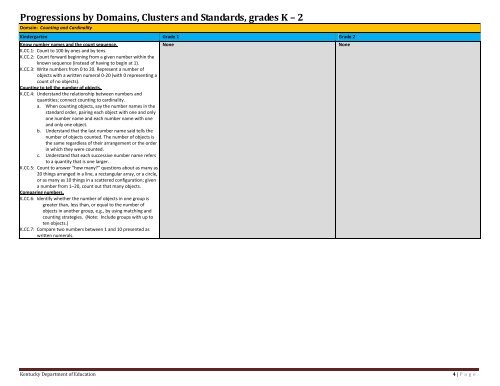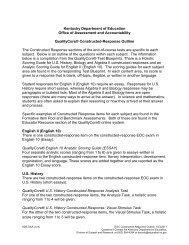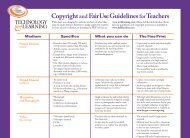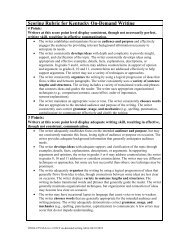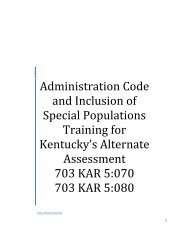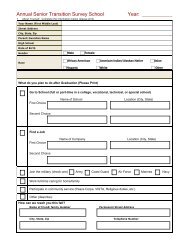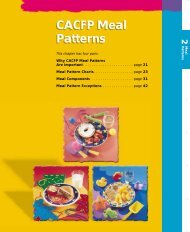Standards with Progressions grades K-HS v. 1.3 - Kentucky ...
Standards with Progressions grades K-HS v. 1.3 - Kentucky ...
Standards with Progressions grades K-HS v. 1.3 - Kentucky ...
- No tags were found...
Create successful ePaper yourself
Turn your PDF publications into a flip-book with our unique Google optimized e-Paper software.
<strong>Progressions</strong> by Domains, Clusters and <strong>Standards</strong>, <strong>grades</strong> K – 2<br />
Domain: Counting and Cardinality<br />
Kindergarten Grade 1 Grade 2<br />
Know number names and the count sequence.<br />
K.CC.1: Count to 100 by ones and by tens.<br />
K.CC.2: Count forward beginning from a given number <strong>with</strong>in the<br />
known sequence (instead of having to begin at 1).<br />
K.CC.3: Write numbers from 0 to 20. Represent a number of<br />
objects <strong>with</strong> a written numeral 0-20 (<strong>with</strong> 0 representing a<br />
count of no objects).<br />
Counting to tell the number of objects.<br />
K.CC.4: Understand the relationship between numbers and<br />
quantities; connect counting to cardinality.<br />
a. When counting objects, say the number names in the<br />
standard order, pairing each object <strong>with</strong> one and only<br />
one number name and each number name <strong>with</strong> one<br />
and only one object.<br />
b. Understand that the last number name said tells the<br />
number of objects counted. The number of objects is<br />
the same regardless of their arrangement or the order<br />
in which they were counted.<br />
c. Understand that each successive number name refers<br />
to a quantity that is one larger.<br />
K.CC.5: Count to answer “how many” questions about as many as<br />
20 things arranged in a line, a rectangular array, or a circle,<br />
or as many as 10 things in a scattered configuration; given<br />
a number from 1–20, count out that many objects.<br />
Comparing numbers.<br />
K.CC.6: Identify whether the number of objects in one group is<br />
greater than, less than, or equal to the number of<br />
objects in another group, e.g., by using matching and<br />
counting strategies. (Note: Include groups <strong>with</strong> up to<br />
ten objects.)<br />
K.CC.7: Compare two numbers between 1 and 10 presented as<br />
written numerals.<br />
None<br />
None<br />
<strong>Kentucky</strong> Department of Education<br />
4 | P a g e


